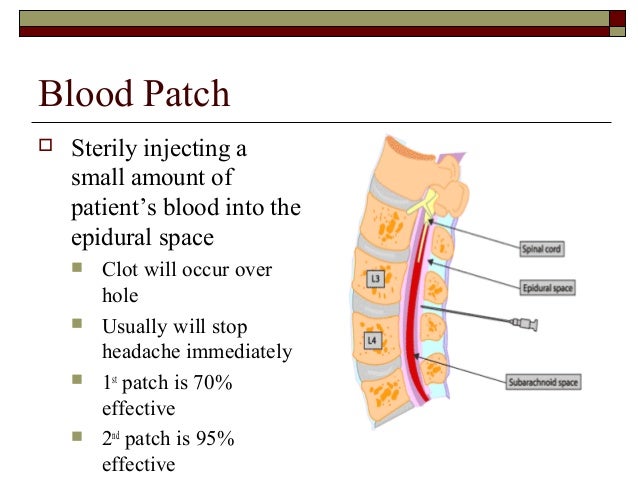Soooo......while i was in the Hospital recovering from giving birth to my son I developed a major migraine headache. so the anaesthesiologist came in to my room and perform a blood patch so i never really understood what it was til now
WHAT IS AN EPIDURAL BLOOD PATCH? An epidural blood patch is an injection of your blood into the epidural space. The epidural space is not an injection into the spinal cord itself. The spinal cord and spinal nerves are in a “sack” containing clear fluid (cerebrospinal fluid). The area outside this “sack” is called the epidural space.
WHY IS this procedure perform? There are certain conditions under which patients will have had injections in the spinal column. Examples include an epidural during labor, a diagnostic spinal tap, a therapeutic spinal injection, etc. A small number of patients will experience a severe headache after the procedure, usually worse with standing and better when lying down. This is due to a persistent leak of spinal fluid into the epidural space. Although the headache itself is harmless, it can be very severe and very debilitating.
HOW LONG DOES IT TAKE TO DO? The actual injection takes only a few minutes. Including talking to your doctor before the procedure, signing the informed consent, positioning in the room, and observation by the recovery room nurse afterwards.
WILL IT HURT?All of our procedures begin by injecting a small amount of local anesthetic through a very small needle. It feels like a little pinch and then a slight burning as the local anesthetic starts numbing the skin. After the skin is numb, the procedure needle feels like a bit of pressure at the injection site.
HOW IS IT DONE? It is typically done with you lying on your stomach. Your blood pressure and oxygen levels will be monitored. The skin on the back is cleaned with antiseptic solution. A separate area where a good vein is available is also cleaned with antiseptic solution. A small intravenous catheter is placed in the vein. After the doctor has placed the epidural needle near the affected area, he will draw about 20-25 cc of blood from your vein and will then gradually inject the blood.
WHAT SHOULD I EXPECT AFTER THE INJECTION? Immediately after the injection, you may feel pressure in the back. This is due to the effect of the blood in the epidural space. After resting for about 30 minutes, you will be asked to stand up. Typically, most patients experience significant relief immediately. After a few hours, your body will have had a chance to replenish the lost spinal fluid and your headache should continue to get better.
WHAT ARE THE RISKS AND SIDE EFFects? Commonly encountered side effects are increased pain from the injection (usually temporary), rarely inadvertent puncture of the“sack” containing spinal fluid (may not relieve your headaches), infection, bleeding, nerve damage, or no relief from your headache.
WHO SHOULD NOT HAVE THIS INJECTION? If you are allergic to any of the medications to be injected, if you are on a blood-thinning medication (e.g. coumadin, injectable heparin), or if you have an active infection going on.
References : portlandpaincare.com
